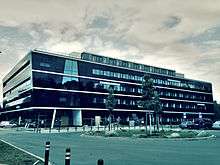Max Planck Institute for the Science of Light
 The new building of the MPL in Erlangen | |
| Abbreviation | MPL |
|---|---|
| Formation | 2009 |
| Type | Scientific institute |
| Purpose | Research in optics and photonics |
| Headquarters | Erlangen, Germany |
| Coordinates | 49°34′57″N 11°01′38″E / 49.582461°N 11.027331°E |
Key people | Gerd Leuchs, Philip Russell, Vahid Sandoghdar |
Parent organization | Max Planck Society |
| Website | http://www.mpl.mpg.de/ |
Formerly called | Max Planck Research Group for Optics, Information and Photonics |
The Max Planck Institute for the Science of Light (MPL) performs basic research in optical metrology, optical communication, new optical materials, plasmonics and nanophotonics and optical applications in biology and medicine. It is part of the Max Planck Society and was founded on January 1, 2009 in Erlangen near Nuremberg. The Institute is based on the Max Planck Research Group "Optics, Information and Photonics", which was founded in 2004 at the University of Erlangen-Nuremberg, as a precursor. The institute currently comprises five divisions.
Structure
The institute currently is organized in five divisions, each led by a director with equal rights. The institute researchers are supported by several scientifically active technology development and service units. The institute is also the home of several Max Planck research groups that are organizationally independent of the divisions. The MPL hosts an International Max Planck Research School Physics of Light . Through the appointment of the directors and affiliated professors as university professors, through several affiliated groups and participation in graduate schools, a collaboration between the MPL and the University of Erlangen-Nuremberg is maintained.[1]
Division Leuchs - "Optics and Information"
The head of this division Prof. Gerd Leuchs is the first founding director. He held the chair of optics at the University of Erlangen-Nuremberg, which is now integrated in the MPL. The range of topics investigated includes classical optics (optical 3D metrology, interferometry, high-resolution interferometry, etc.) as well as quantum information processing and nanophotonics.
Division Russell - "Photonic Crystal Fibres"
The division "Photonics and New Materials" is led by Prof. Philip St. J. Russell. The winner of the prestigious Körber European Science Prize was awarded the Alfried Krupp von Bohlen und Halbach chair with his move from the University of Bath to Erlangen. The division investigates new optical materials, especially photonic crystal fibers.
Division Marquardt - "Theory"
The theory division is headed by Florian Marquardt. The research of the division is mainly concerned with light-matter interaction, the topics covered include cavity optomechanics and interaction of electromagnetic radiation with qubits, as well as many-body physics.[2]
Division Sandoghdar - "Nanooptics"
In 2010 Prof. Vahid Sandoghdar was appointed the third director of the Max Planck Institute for the Science of Light. Sandoghdar, previously working at ETH Zurich, was awarded the prestigious Alexander von Humboldt Professorships at the University of Erlangen-Nuremberg. His fields of interest comprise nanooptics, biophotonics and plasmonics. [3]
Division Guck - "Physics & Medizine"
On Oktober 1st, 2018 Jochen Guck was named Direktor of the new Division "Physiks & Medizine". His team will do basic research in the field of biophysics and in the interface between physics and medicine. In the coming years Guck will move to the Max Planck Centre for Physics & Medicine (MPZ-PM), which is beeing built in a cooperation with the Friedrich-Alexander University Erlangen-Nuernberg and the University Hospital Erlangen.
Max Planck Research Groups
Technology Development and Service Units
- TDSU 1: Micro- and nanostructuring,
- TDSU 2: Optical technologies,
- TDSU 3: Fiber fabrication and glass studio.
Former research groups
- Junior research group "integrated quantum optics", led by Christine Silberhorn,
- Research group "Nonlinear photonic nanostructure", led by Fabio Biancalana,
- Research group "Optical quantum information theory", led by Peter van Loock,
- Max Planck fellow group "Laser Physics and Photonics" led by Prof. Dr. Lijun Wang with a focus on optical high precision measurements.
History

The purpose of Max Planck Research Groups (MPRG) at various universities is to strengthen networking between universities and institutes of the Max Planck Society.
In 2004, the Max-Planck Society established a new Max Planck Research Group, "Optics, Information, and Photonics", at the Friedrich-Alexander-University, Erlangen-Nuremberg to advance collaboration between that university and the Max Planck Society. In June 2008, after an evaluation, the senate of the Max Planck Society decided to convert this group to a Max Planck institute and thereupon founded the "Max Planck Institute for the Science of Light" (German "Max-Planck-Institut für die Physik des Lichts").[7] with effect from January 1, 2009.
In 2016, the new building was opened. The project was made by the Munich architecture bureau Fritsch + Tschaidse Architekten GmbH.[8]
References
- ↑ "Organizational Chart and Information". Max Planck Institute for the Science of Light. Retrieved 21 July 2015.
- ↑ "Max Planck Institute for the Science of Light - Marquardt Division". www.mpl.mpg.de. Retrieved 2018-09-25.
- ↑ Sandoghdar. "Max Planck Insitute of the Science of Light - Sandoghdar Division - Welcome to the Sandoghdar Divisionat the Max Planck Institute for the Science of Light". www.mpl.mpg.de. Retrieved 2018-09-25.
- ↑ "Max Planck Institute for the Science of Light - Research". www.mpl.mpg.de. Retrieved 2018-09-25.
- ↑ "Max Planck Institute for the Science of Light - Genes Research Group". www.mpl.mpg.de. Retrieved 2018-09-25.
- ↑ "Max Planck Institute for the Science of Light - Viola-Kusminskiy Research Group". www.mpl.mpg.de. Retrieved 2018-09-25.
- ↑ Max-Planck-Gesellschaft – Presseinformation
- ↑ "Universities and Research Institutes". MBBM. Retrieved 7 July 2017.